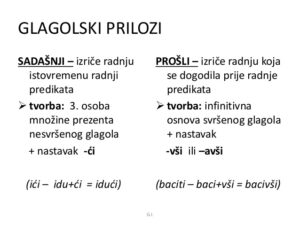
They are common in literature and other written works, while in spoken language simple present or past tense constructions are usually used instead.
The present verbal adverb (glagolski prilog sadašnji) shows the cation that is happening at the same time as some other action. It is formed by adding the ending -ći to the third-person plural present form of an imperfective verb:
pjevati > 3pl pjevaju > pjevajući “(while) singing”
ljubiti > 3pl ljube > ljubeći “(while) kissing”
The past verbal adverb (glagolski prilog prošli) is formed by adding the ending -vši to the infinitive stem of a perfective verb:
otpjevati > otpjeva- infinitive stem > otpjevavši “having sung”
poljubiti > poljubi- infinitive stem > poljubivši “having kissed”
Some perfective verbs have irregular past verbal adverbs, for example doći > došavši “having come”.
The verb biti has the present verbal adverb budući and the past verbal adverb bivši.
EXERCISES:
- _________ (ulaziti) u učionicu, čuo sam muziku.
- Idem kući _____________ (pjevati).
- Mara je pojela čokoladu ____________ (ne misliti) na svoju sestru.
- ___________ (shvatiti) da će zakasniti, požurili su u školu.
- ___________ (šetati) gradom, srela je staru prijateljicu.
- ___________ (misliti) o njemu, nije mogla uživati u lijepom danu.
- ___________ (slušati) njen glas, sva se naježila.
- ___________ (doučkovati) na brzinu izjuri iz stana.
- ____________ (trčati) prema kući, pratio ga je mjesec.
